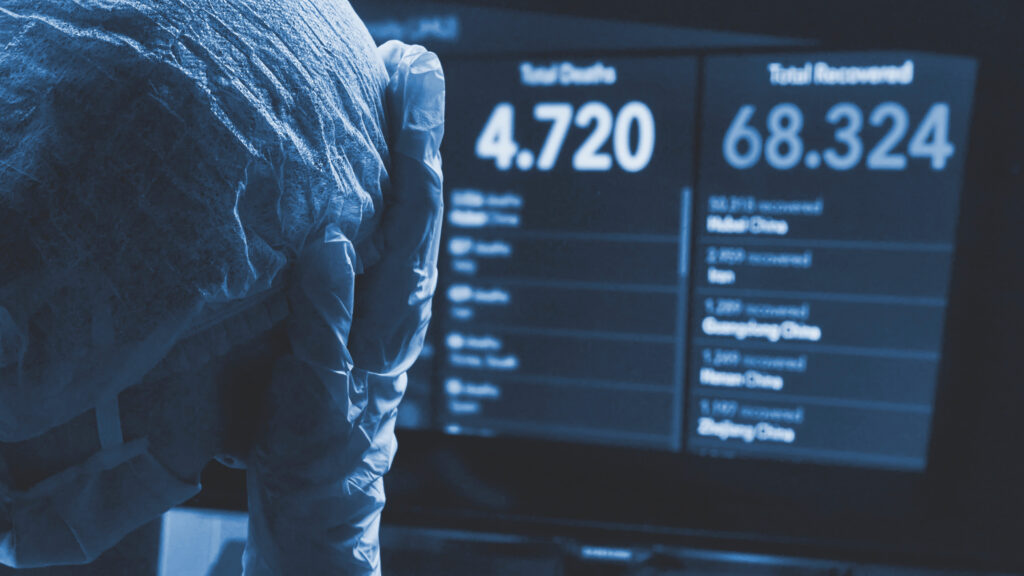Burnout by the numbers
There’s no shortage of research on the extent of clinician burnout. The role of the pandemic notwithstanding, the news is not good.

Clinician stress levels were already high before the COVID-19 pandemic, and, the many changes implemented to cope with the infectious disease strangely brought some relief for clinicians.
While clinicians lacked protective equipment and knowledge about how to treat the disease, the disruption of face-to-face care relaxed some challenges that had provided fertile ground for burnout, says Andrew Hajde, director of content and consulting at the Medical Group Management Association.
“During the pandemic, we were showing (lower) levels of burnout,” he says. “A lot of them had practices closed, volumes restricted and were able to spend a lot of time at home. They got a break from all of the ancillary factors caused their stress to go down.”
And for a while, doctors and nurses were acknowledged as heroes in the front lines of the COVID war.
It didn’t last. Clinicians became objects of scorn to some who disavowed science, and that cognitive dissonance now only adds to the burnout crisis, he contends.
Dire statistics
The most recent barometer of clinicians’ professional despair came early in 2023 with the release by Medscape of its 2023 U.S. Physician Burnout and Depression Report, entitled, “I Cry but No One Cares.” It found that both continue to worsen and have increased substantially in the past five years.
Select data from the report includes:
- • Rates of burnout increased to 53 percent this past year, from 47 percent in 2021. Also, 23 percent of physicians reported depression in 2022, compared with 15 percent in 2018.
- • Specialties most likely to report burnout include emergency department physicians (65 percent), internal medicine (60 percent), pediatrics (59 percent) and OB/GYN and infectious diseases (both at 58 percent).
- • Nearly two-thirds of physicians (62 percent) report that they’ve felt burned out for longer than one year.
- • Far and away, having too many bureaucratic tests was reported to contribute most to burnout (by 61 percent of physicians).
- • Some 43 percent of physicians say burnout is having a strong or severe impact on their lives; 65 percent say it’s affecting their relationships. But only 13 percent say they’ve sought professional help to reduce burnout.
The results of the Medscape survey build on findings of a study by the American Medical Association, the Mayo Clinic, Stanford University School of Medicine and the University of Colorado School of Medicine, which found growing burnout, after a moderate decline in symptoms since 2014.
Overall, 62.8 percent of physicians had at least one manifestation of burnout in 2021, compared with 38.2 percent in 2020, 43.9 percent in 2017, 54.4 percent in 2014 and 45.5 percent in 2011.
Stress on life, professional practice
Looking at work-life integration (WLI), the study found “a dramatic increase in burnout and decrease in satisfaction with WLI occurred in US physicians between 2020 and 2021.” The results suggest “that the increase in physician distress was overwhelmingly work-related. Given the association of physician burnout with quality of care, turnover and reductions in work effort, these findings have profound implications for the US healthcare system.”
The U.S. Surgeon General, in its 2022 report on health worker burnout, places the blame on a variety of workplace systems. “There are a range of societal, cultural, structural and organizational factors that contribute to burnout among health workers,” the report concludes, noting that workforce shortages are an inevitable byproduct of stress. It notes the most recent predictions from The Association of American Medical Colleges of a shortage of 54,100 to 139,000 physicians by 2033.
Also in 2022, a survey by the Medical Group Management Association and Jackson Physician Search, a recruitment firm, found that physician burnout and turnover rates remain “dangerously high,” attributing the trend to the stress of the COVID-19 pandemic and resulting staffing shortages.
The report is based on data from hundreds of administrators and physicians surveyed in August 2022 by Jackson Physician Search. Findings include:
- • Nearly two-thirds of physicians (65 percent) report they are experiencing burnout, up 4 percentage points from 2021.
- • Of those experiencing burnout, 35 percent said their levels of burnout “significantly increased” in 2022.
- • Some 51 percent of physicians have considered leaving their current employer, up from 46 percent in 2021.